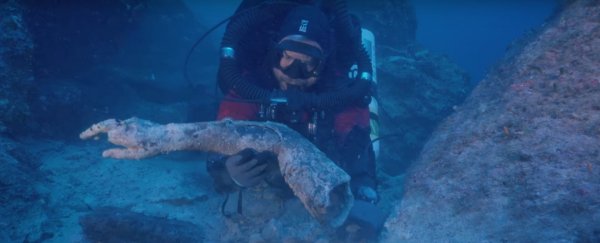The Roman shipwreck that once housed the mysterious Antikythera Mechanism - often referred to as the world's oldest computer - just got a lot more interesting.
The latest dive to excavate artefacts from the wreck off the coast of Antikythera, Greece, has yielded up new treasure that hints at at much more to come.
Hidden under boulders in a previously unexplored section of the site, the excavation team uncovered, among other items, the lid of a sarcophagus, a mysterious bronze disc decorated with a bull, and a life-sized human arm from a bronze statue.
But perhaps the most tantalising thing they brought back was an indication that there is still a lot more from the almost 2,100-year-old Greek shipwreck to be retrieved, thanks to a bespoke metal detector that has revealed the presence of a large cache of metal.
"There should be at least seven statues," diver Alexandros Sotiriou told The Guardian.
How did the team arrive at that count? Because in 1900-01, the sponge divers that discovered the wreck already retrieved orphan limbs from six different statues. This new limb marks the seventh - and if we can find and retrieve those statues, it will be a treasure of unimaginable value.
 Brett Seymour/EUA/ARGO 2017
Brett Seymour/EUA/ARGO 2017
This is because so few bronze statues from classical Greece have survived. Bronze was a valuable material, and many statues were melted down so that it could be reused. Many others were lost at sea.
Fewer than 200 bronzes are known to be extant today, including heads without bodies and bodies without heads.
One of those is the Antikythera Youth, retrieved from the wreck in fragments in 1900-1901, and pieced back together in 1902 - so there's strong precedent to suggest that complete statues could eventually be raised from the seafloor.
The dive to the 50-metre-deep wreck, conducted by the Greek Ephorate of Underwater Antiquities and Lund University, took place from 4 to 20 September 2017 in a region that had been buried by boulders shifted by earthquakes over the almost 2,100 years since the wreck.
Because this area was undisturbed by previous excavations, the team is excited. "We think this means that everything is down there still," Brendan Foley from the University of Lund told Nature.
The wreck came to fame after the discovery of a mysterious item called the Antikythera Mechanism, pictured below, the purpose of which has been puzzling scientists since it was first excavated in 1901.
 The Antikythera Mechanism. Image: Marsyas/WikiCommons
The Antikythera Mechanism. Image: Marsyas/WikiCommons
The disc-shaped device has a system of gears inside, and is thought to be a computer of some kind to study the sky.
One of the items retrieved from the recent dive appeared, superficially, to resemble the Antikythera Mechanism - bronze, disc-shaped, with four short arms with holes for screws, heavily encrusted with sediment.
The team hoped that it might be part of the Mechanism and would yield more clues as to its purpose.
 Reconstruction of the newly discovered disc. Image: EUA (left) and Alexander Tourtas
Reconstruction of the newly discovered disc. Image: EUA (left) and Alexander Tourtas
But intriguingly, CT scanning revealed not gears, but the image of a bull hidden under the layers of sediment, reconstructed by an artist as seen in the image above. It was probably, the researchers think, a decorative element, perhaps for a shield. More detailed study will take place over the coming weeks.
Previously, the Greek government's Return to Antikythera project has brought up glassware, marble statues, ceramic amphorae, lamps, and even a 2,100-year-old human skeleton, the DNA of which could reveal more information about who was on the ship, and why.
With this expedition, the team found more human remains, which will hopefully help fill in more of that particular picture, as well as wooden planks that may have been part of the actual ship - and may provide clues as to its size.
The next expedition is planned to take place in May 2018, and the divers are going to go into the ship's hold - where the cargo would have been stored.
"All the other things that would have been carried should be down there as well," Foley said. "Every day is going to be like opening Tut's tomb."
